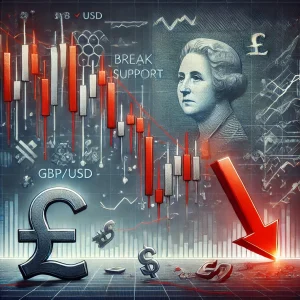Introduction
The US Dollar (USD) has been steadily clinging to its recent recovery gains, drawing close attention from investors worldwide. As the forex market remains sensitive to US economic data and Federal Reserve (Fed) commentary, traders are eagerly awaiting new insights into the central bank’s future monetary policy. The USD has maintained its strength against major currencies despite a volatile macroeconomic environment, driven largely by expectations of Fed interest rate policies and broader economic performance.
In this article, we will explore the factors behind the USD’s performance, how market participants are responding, and what to expect moving forward as new economic data is released and the Fed’s statements are carefully monitored.
US Dollar’s Recovery: A Closer Look
Over the past few weeks, the US Dollar has shown remarkable resilience, rebounding from previous declines against key currencies like the Euro (EUR), British Pound (GBP), and Japanese Yen (JPY). This recovery is largely fueled by strong investor confidence in the Fed’s ability to navigate the current economic conditions and manage inflation pressures through policy adjustments.
The USD’s recovery comes at a time when global markets are still grappling with inflationary trends, supply chain disruptions, and geopolitical tensions. These factors have contributed to market uncertainty, prompting traders to seek safe-haven currencies like the USD, which benefits from the US economy’s relative strength.
The greenback’s resilience can also be attributed to stronger-than-expected economic data, particularly in the labor market. The recent release of non-farm payrolls (NFP) data showed a significant rise in employment, reinforcing the Fed’s stance that the economy is robust enough to withstand interest rate hikes without causing undue harm to growth.
Key Drivers Of USD Strength
US Economic Data
The ongoing recovery of the US Dollar is heavily influenced by positive economic indicators, particularly employment data and inflation reports. The strong NFP report highlighted the labor market’s resilience, with more jobs added than initially expected, which bolstered the USD’s position in the forex market. Furthermore, inflation readings, while elevated, have remained within manageable limits, allowing the Fed some flexibility in its policy approach.
Federal Reserve Commentary
Investors’ focus remains on upcoming statements from Federal Reserve officials, particularly Chair Jerome Powell. The Fed’s current strategy has been to maintain a data-driven approach, with the possibility of further interest rate hikes depending on inflation and economic growth metrics. Fedspeak, or the commentary from various Fed officials, often provides crucial clues about future policy adjustments, which in turn affect forex market sentiment.
Recent comments from Powell suggested that while inflation remains a concern, the central bank is prepared to continue raising interest rates if necessary to prevent the economy from overheating. This hawkish stance has supported the USD’s rise, as higher interest rates typically attract foreign investors seeking better returns on US assets.
Geopolitical Tensions
Global geopolitical tensions have also played a role in bolstering the US Dollar. With ongoing uncertainties in regions like Eastern Europe and the Middle East, the USD’s status as a safe-haven currency has been reinforced. Investors often flock to the USD during times of international instability, as the US economy is perceived to be more insulated from external shocks compared to other major economies.
Impact On Major Currency Pairs
EUR/USD
The Euro (EUR) has struggled to regain ground against the US Dollar in recent trading sessions. The EUR/USD pair, which is one of the most heavily traded in the forex market, has been weighed down by the divergence between US and European economic conditions. While the Eurozone has seen some recovery, particularly in industrial production and exports, inflationary pressures and energy concerns remain significant headwinds.
The ECB (European Central Bank) has been more cautious in its policy approach compared to the Fed, which has led to a widening gap between US and Eurozone interest rates. This has made the USD more attractive to investors, contributing to the EUR’s decline against the greenback.
GBP/USD
The British Pound (GBP) has similarly faced difficulties in maintaining its strength against the US Dollar. The GBP/USD pair has been affected by the UK’s own inflationary challenges, as well as concerns over the Bank of England’s (BoE) ability to manage the economy’s recovery post-Brexit. While the BoE has raised interest rates, it has not matched the pace of the Fed’s tightening, leading to a weaker Pound.
Moreover, the UK’s economic outlook remains clouded by labor shortages, rising energy costs, and sluggish growth, further undermining the GBP’s position relative to the USD.
USD/JPY
In contrast to the EUR and GBP, the Japanese Yen (JPY) has seen even more pronounced weakness against the USD. The USD/JPY pair has surged in recent weeks, as the Bank of Japan (BoJ) maintains its ultra-loose monetary policy. The BoJ’s reluctance to raise interest rates, coupled with Japan’s slow recovery from the pandemic, has made the Yen less attractive to investors, leading to a stronger USD/JPY exchange rate.
Outlook For The US Dollar
As the forex market looks ahead, several key factors will determine the future trajectory of the US Dollar. Investors will be paying close attention to upcoming US economic data releases, including inflation reports, retail sales figures, and additional labor market updates. Any surprises in these indicators could cause significant volatility in the USD’s performance.
Moreover, the Fed’s next moves will be closely scrutinized. If the central bank signals more aggressive rate hikes, the USD could continue to strengthen, especially if other central banks remain dovish in comparison. On the other hand, any signs of the Fed pausing or slowing down its tightening cycle could lead to a pullback in the USD’s recent gains. Geopolitical developments will also play a crucial role, as any escalation in global tensions could further drive demand for safe-haven assets like the US Dollar.
Conclusion
The US Dollar’s recovery continues to be supported by strong economic data, hawkish Fed commentary, and global geopolitical uncertainties. As the forex market remains focused on upcoming US data releases and Fedspeak, traders should prepare for potential volatility in the coming weeks. While the USD remains in a strong position, much will depend on how the economic and geopolitical landscapes evolve.



